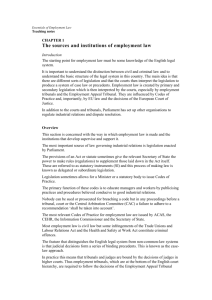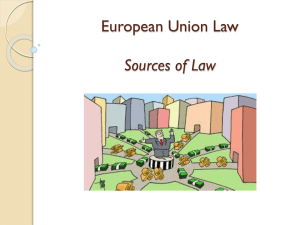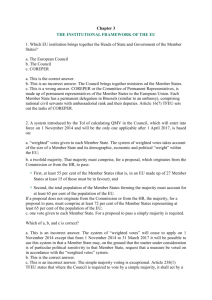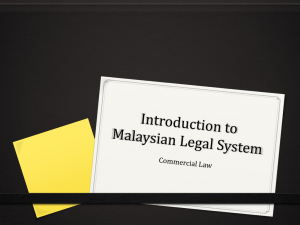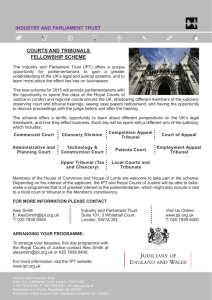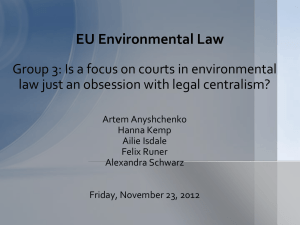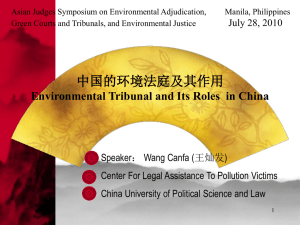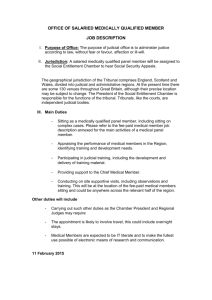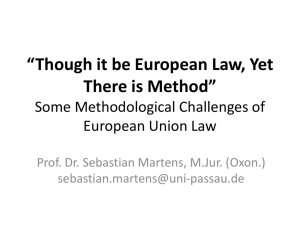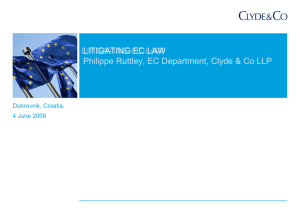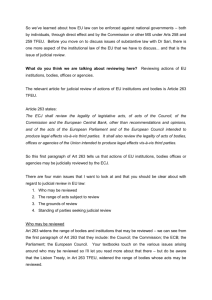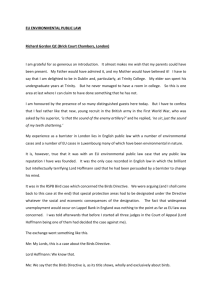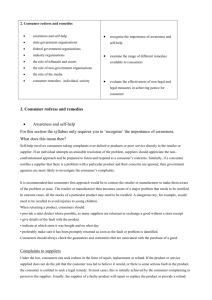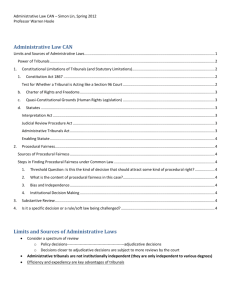Lecture 15.11.2011
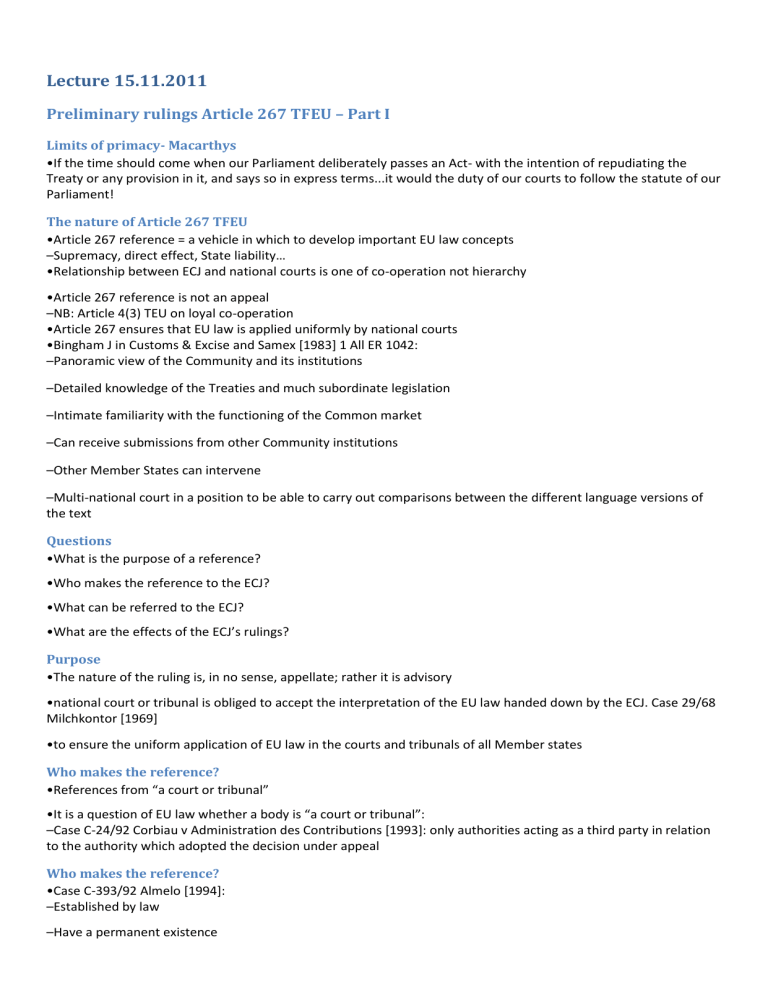
Lecture 15.11.2011
Preliminary rulings Article 267 TFEU – Part I
Limits of primacy- Macarthys
•If the time should come when our Parliament deliberately passes an Act- with the intention of repudiating the
Treaty or any provision in it, and says so in express terms...it would the duty of our courts to follow the statute of our
Parliament!
The nature of Article 267 TFEU
•Article 267 reference = a vehicle in which to develop important EU law concepts
–Supremacy, direct effect, State liability…
•Relationship between ECJ and national courts is one of co-operation not hierarchy
•Article 267 reference is not an appeal
–NB: Article 4(3) TEU on loyal co-operation
•Article 267 ensures that EU law is applied uniformly by national courts
•Bingham J in Customs & Excise and Samex [1983] 1 All ER 1042:
–Panoramic view of the Community and its institutions
–Detailed knowledge of the Treaties and much subordinate legislation
–Intimate familiarity with the functioning of the Common market
–Can receive submissions from other Community institutions
–Other Member States can intervene
–Multi-national court in a position to be able to carry out comparisons between the different language versions of the text
Questions
•What is the purpose of a reference?
•Who makes the reference to the ECJ?
•What can be referred to the ECJ?
•What are the effects of the ECJ’s rulings?
Purpose
•The nature of the ruling is, in no sense, appellate; rather it is advisory
•national court or tribunal is obliged to accept the interpretation of the EU law handed down by the ECJ. Case 29/68
Milchkontor [1969]
•to ensure the uniform application of EU law in the courts and tribunals of all Member states
Who makes the reference?
•References from “a court or tribunal”
•It is a question of EU law whether a body is “a court or tribunal”:
–Case C-24/92 Corbiau v Administration des Contributions [1993]: only authorities acting as a third party in relation to the authority which adopted the decision under appeal
Who makes the reference?
•Case C-393/92 Almelo [1994]:
–Established by law
–Have a permanent existence
–Exercise binding jurisdiction
–Be bound by rules of adversary (inter partes) procedure
–Apply the rule of law
–Be independent cases 246/80, Broekmeulen [1981], case 102/81, Nordsee [1982] and case 516/99, Walter Schmid [2002];
Standesamt Stadt Niebull [2006]
Who makes the reference?
•Article 267 distinguishes between courts that “may” refer and courts that “shall” refer:
–Article 267(2): discretion to refer
–Article 267(3): duty to refer
Who makes the reference?
Article 267, 2nd paragraph:
“Where such a question is raised before any court or tribunal of a Member State, that court or tribunal may, if it considers that a decision on the question is necessary to enable it to give judgment, request the Court to give a ruling thereon.”
Who makes the reference?
•Case 166/73 Rheinmuehlen [1974]:
–“… national courts have the widest discretion in referring matters to the Court of Justice if they consider that a case pending before them raises questions involving interpretation, or consideration of the validity, of provisions of
Community law, necessitating a decision on their part.”
•Courts ask questions “if they consider that a case pending before them raises questions involving interpretation.”
•A national legislation or procedure making a reference difficult or impossible is contrary to EU law
•The Treaty seems to grant the same degree of discretion to national courts whether the question is one of interpretation or one of validity of EU law
•However, the ECJ has ruled that national courts have no power to declare a Community act invalid
–Case 314/85 Foto-Frost [1987]
Article 267, 3rd paragraph:
“Where any such question is raised in a case pending before a court or tribunal of a Member State against whose decisions there is no judicial remedy under national law, that court or tribunal shall bring the matter before the
Court of Justice.”
•The national court against whose decisions there is no judicial remedy under national law is required to make a reference
•What is the court of last resort?
–Abstract theory: the court whose decisions are never subject to appeal
–Concrete theory: the court whose decision in the case in question is not subject to appeal
–Case 6/64 Costa v ENEL [1964]: highest court in the case (concrete theory)
•Obligation seems to be automatic
•However, the ECJ has introduced some flexibility:
–the question is irrelevant
•Case 283/81 Cilfit [1982]
–the question has already been interpreted by the Court (“Acte éclairé”)
•Cases 28-30/62 Da Costa [1963]
–the “Acte clair” theory
•Case 283/81 Cilfit [1982]
“Acte clair theory”
•Case 283/81 Cilfit [1982]:
–“… a court or tribunal against whose decisions there is no judicial remedy under national law is required… to comply with its obligations to bring the matter before the Court, unless… it has established that… the correct application is so obvious as to leave no scope for any reasonable doubt. The existence of such possibility must be assessed in light of the specific characters of Community law, the particular difficulties to which its interpretation gives rise and the risk of divergence in judicial decisions within the Community.”
•What could be done in the absence of a reference which would have been necessary to decide the case?
–Direct action by the Commission
–Damages against the State for breach of Community law: Koebler [2003]
–Should we set up an appeal mechanism?
What can be referred?
Article 267, 1st paragraph:
“The Court of Justice shall have jurisdiction to give preliminary rulings concerning:
(a) the interpretation of this Treaty;
(b) the validity and interpretation of acts of the institutions of the Community and of the ECB;
(c) the interpretation of the statutes of bodies established by an act of the Council, where those statutes so provide.”
